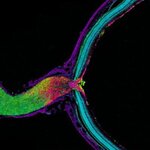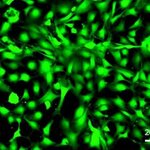Genetics & Molecular Biology

Researchers have developed a new technique to control populations of a major livestock pest in Australia and New Zealand.
They genetically modified lines of female Australian sheep blowflies (Lucilia cuprina), making female flies dependent upon a common antibiotic -
tetracycline
- to survive.
Dr. Max Scott, professor of entomology at North Carolina State University, and colleagues say that female blowflies that did not receive the antibiotic died in the late larval or pupal stages, before reaching adulthood. Several genetically modified lines lacking tetracycline showed 100 percent…

Chronic tissue inflammation is typically associated with obesity and metabolic disease, but new research finds that a level of "healthy" inflammation is necessary to prevent metabolic diseases, such as fatty liver.
Using animal models, the researchers found that suppressing inflammation in fat tissue results in reduced fat expansion and thus leaner mice, even when the animals are fed a high-fat diet.
The team expected to find that the reduced body fat content would lead to improvements in metabolism and a lower incidence of metabolic disease. Unexpectedly, the team found that the lean mice…

Mitochondria are cell organelles located within animal and human cells. They produce energy for the organism, possess their own genetic material - mitochondrial DNA (mtDNA) - and are transmitted exclusively by the mother.
Depending on their activity and tasks, different numbers of mitochondria are present in a cell - usually a few hundred to a thousand per body cell.
Inherited mitochondrial disorders - mitochondropathies - occur in about one of 10,000 humans throughout the world. Diseases such as diabetes, stroke, cardiac defects, epilepsy, or muscle weakness may originate from mitochondrial…

Some basic biology may need revising. It's broadly assumed that cells degrade and recycle their own old or damaged organelles, but researchers writing in PNAS say that some neurons transfer unwanted mitochondria, the tiny power plants inside cells, to supporting glial cells called astrocytes for disposal.
The researchers looked specifically at the axons of retinal ganglion cells in mice, a type of neuron that transmits visual information from the eye to the brain. The investigation was prompted by observations while studying a mouse model of glaucoma that protein products from the…

The kidney, unlike its neighbor the liver, was once understood to be a static organ once it had fully developed, but doctors have observed patients with kidney disease experiencing renal regeneration.
A new study conducted by researchers at Sheba Medical Center, Tel Aviv University and Stanford University have pinpointed the precise cellular signaling responsible for renal regeneration and exposing the multi-layered nature of kidney growth. The research was conducted by principal investigators Dr. Benjamin Dekel of TAU's Sackler School of Medicine and Sheba Medical Center and Dr.…

In the most comprehensive genetic study of the Mexican population to date, researchers from Mexico's National Institute of Genomic Medicine (INMEGEN), UC San Francisco and Stanford University, have identified tremendous genetic diversity.
So much diversity there basically are no Mexicans. But it explains some confounding aspects of Latino health, like why there is such a variety of health factors among Latinos of Mexican descent, including differing rates of breast cancer and asthma, as well as therapeutic response.
The study documented nearly one million genetic…

Researchers have developed biomaterials for bone regeneration from beer brewing waste.
A collaboration among the Mahou and Createch Co., Universidad Politécnica de Madrid (UPM) and the Institute of Materials Science and the Institute of Catalysis and Petrochemistry of Consejo Superior de Investigaciones Científicas (CSIC), has developed biocompatible materials to be used as support for bone regeneration from bagasse (residue) left over after beer brewing.
Bagasse is constituted by organic waste from malt, never experiencing modifications afterwards. This is the reason why bagasse is…

A molecular pathway called mTORC1 controls the conversion of unhealthy white fat into beige fat, an appealing target for increasing energy expenditure and reducing obesity, according to a new study. The team also found that a protein, Grb10, serves as the on-off switch for mTORC1 signaling and the "beigeing" of fat.
Grb10 is stimulated by cold stress, which causes the body to burn energy. ""We know that if we want to keep our body lean, we have to get rid of extra nutrients in the body, which means burning more energy," said senior author Feng Liu, Ph.D., professor of pharmacology at the UT…

Researchers have found a way to prevent nonalcoholic fatty liver disease, the most common cause of chronic liver disease worldwide, in mice.
By blocking a path that delivers dietary fructose to the liver, mice were prevented from developing the condition, according to investigators at Washington University School of Medicine in St. Louis writing in the Journal of Biological Chemistry.
In people, nonalcoholic fatty liver disease often accompanies obesity, elevated blood sugar, high blood pressure and other markers of metabolic syndrome. Some estimate as many as 1 billion people worldwide have…

Like blonde hair? You can thank the Kit ligand gene.
A single-letter change in the genetic code is enough to generate blond hair in humans, according to a new analysis by Howard Hughes Medical Institute scientists which has pinpointed that change, common in the genomes of Northern Europeans.
A handful of genes likely determine hair color in humans and the precise molecular basis of the trait remains poorly understood, and discovery of the genetic hair-color switch didn't begin with a deep curiosity about golden locks. It began with fish.
"This particular genetic variation in humans is…